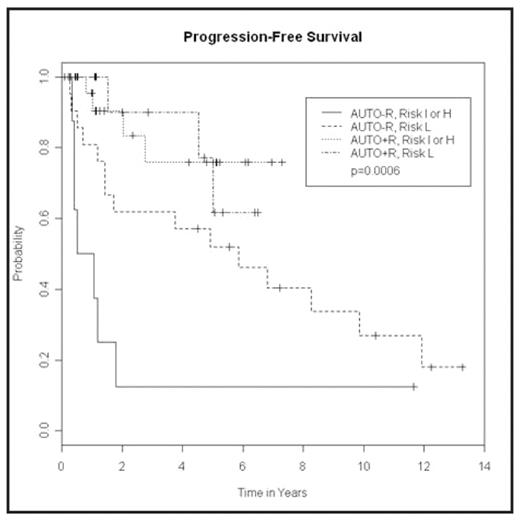Abstract
FLIPI is emerging as an important prognostic factor in patients (pts) with FL. In order to determine its significance in FL pts undergoing AUTO, we examined the outcome of 75 consecutive pts transplanted at the MD Anderson Cancer Center between 02/94 and 04/08. Pts were eligible if they had relapsed chemosensitive disease, and had no HLAidentical sibling donor. Twenty-nine pts were transplanted without rituximab (AUTO-R), and 46 pts received high-dose rituximab (AUTO+R) during stem cell mobilization and on days +1 and + 8 after transplantation as previously described (Khouri, JCO, 2005). Median age (range) at AUTO was 54 (33–76) and 49 (35–63) for the AUTO+R and AUTO-R groups respectively (P =0.002). FLIPI was determined at the time of transplantation; more patients had intermediate-high risk in AUTO+R than in AUTO-R (58% vs 27.5%, respectively, P = 0.011). Other patients characteristics were balanced for gender, time from diagnosis, histology subtypes (grades 1,2, 3a, and 3b), disease stage, LDH, bulk, B-symptoms, B-2microglobulin, bone marrow involvement, number of prior chemotherapy regimens received, remission status (CR vs PR), functional imaging, and co-morbidity score. Median follow-up (range) in months was 20 (1–88) for AUTO+R and 70 (4–167) for AUTO-R. Progression-free survival (PFS) was significantly different between AUTO+R and AUTO-R (P = 0.004), with estimated three-year PFS of 48% for AUTO-R and 79% for AUTO+R. Using Cox proportional hazards regression models, the # of prior chemotherapy regimens received (<3 vs >/=3) (P = 0.015) was the only factor associated with PFS in the AUTO+R group, whereas both age (P=0.010), and risk based on FLIPI (P=0.019) were independently associated with PFS in the AUTO-R group. Pts with low-risk vs. intermediate/high-risk had three-year PFS of 62% and 13%, respectively, in the AUTO-R group, whereas in the AUTO+R group, three-year PFS was 90% and 76% in the low-risk and intermediate/high-risk pts, respectively (Figure).
Conclusions: These results suggest that the addition of R to the mobilization and conditioning improves the outcome in pts with relapsed chemosensitive FL treated by AUTO. The number of prior chemotherapy regimens received rather than FLIPI score is the most important determinant of outcome in this setting.
Disclosures: Off Label Use: Use of rituximab in stem cell transplantation.
Author notes
Corresponding author


This feature is available to Subscribers Only
Sign In or Create an Account Close Modal